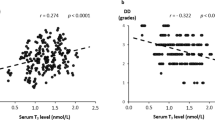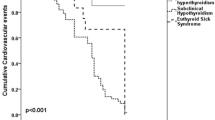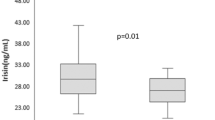Summary
Hyperthyroid heart disease (HHD) is one of the most severe complications of overt hyperthyroidism and increases the risk of mortality in affected patients. Early identification of patients at a higher risk of developing HHD can improve clinical outcomes through active surveillance and management. Connective tissue growth factor (CTGF), a secreted extracellular protein, plays a significant role in cardiac remodeling and dysfunction. We aimed to investigate the association between plasma CTGF level and the risk of HHD in this study. A total of 142 overt hyperthyroid patients without HHD and 99 patients with HHD were included. The plasma CTGF levels were measured using ELISA kits. Routine clinical medical data and echocardiography parameters were recorded for analysis. The plasma CTGF level was significantly higher in patients with HHD than in those without HHD (P=0.002). The plasma CTGF level was positively correlated with free triiodothyronin, tryrotropin receptor antibody, troponin I and lactate dehydrogenase levels and the left atrium diameters, right atrium diameters, and right ventricular end-diastolic diameters (all P<0.05). Logistic regression analysis showed that quartiles 3 and 4 of plasma CTGF levels were significantly associated with the increased risk of HHD (crude OR: 2.529; 95% CI: 1.188–5.387). However, after adjustment for the potentially confounding variables, quartile 4 alone was significantly associated with the higher risk of HHD relative to quartile 1. Hyperthyroid patients with HHD display higher plasma CTGF levels. Furthermore, CTGF is an independent risk factor for HHD. Therefore, the plasma CTGF level may be a potential biomarker for the risk of HHD.
Similar content being viewed by others
References
Taylor PN, Albrecht D, Scholz A, et al. Global epidemiology of hyperthyroidism and hypothyroidism. Nat Rev Endocrinol, 2018,14(5): 301–316
Brandt F, Thvilum M, Almind D, et al. Morbidity before and after the diagnosis of hyperthyroidism: a nationwide register-based study. PLoS One, 2013,8(6):e66711
Brandt F, Green A, Hegedus L, et al. A critical review and meta-analysis of the association between overt hyperthyroidism and mortality. Eur J Endocrinol, 2011,165(4):491–497
Osuna PM, Udovcic M, Sharma MD. Hyperthyroidism and the Heart. Methodist Debakey Cardiovasc J, 2017, 13(2):60–63
Jabbar A, Pingitore A, Pearce SH, et al. Thyroid hormones and cardiovascular disease. Nat Rev Cardiol, 2017,14(1):39–55
Siu CW, Yeung CY, Lau CP, et al. Incidence, clinical characteristics and outcome of congestive heart failure as the initial presentation in patients with primary hyperthyroidism. Heart, 2007,93(4):483–487
Dillmann W. Cardiac hypertrophy and thyroid hormone signaling. Heart Fail Rev, 2010,15(2):125–132
Chen MM, Lam A, Abraham JA, et al. CTGF expression is induced by TGF- beta in cardiac fibroblasts and cardiac myocytes: a potential role in heart fibrosis. J Mol Cell Cardiol, 2000,32(10):1805–1819
Ahmed MS, Oie E, Vinge LE, et al. Connective tissue growth factor—a novel mediator of angiotensin II-stimulated cardiac fibroblast activation in heart failure in rats. J Mol Cell Cardiol, 2004,36(3):393–404
Messaoudi S, Gravez B, Tarjus A, et al. Aldosteronespecific activation of cardiomyocyte mineralocorticoid receptor in vivo. Hypertension (Dallas, Tex: 1979), 2013, 61(2):361–367
Recchia AG, Filice E, Pellegrino D, et al. Endothelin-1 induces connective tissue growth factor expression in cardiomyocytes. J Mol Cell Cardiol, 2009,46(3):352–359
Wang X, McLennan SV, Allen TJ, et al. Adverse effects of high glucose and free fatty acid on cardiomyocytes are mediated by connective tissue growth factor. Am J Physiol Cell Physiol, 2009,297(6):C1490–1500
Chi H, Feng H, Shang X, et al. Circulating Connective Tissue Growth Factor Is Associated with Diastolic Dysfunction in Patients with Diastolic Heart Failure. Cardiology, 2019,143(3–4):77–84
Koitabashi N, Arai M, Niwano K, et al. Plasma connective tissue growth factor is a novel potential biomarker of cardiac dysfunction in patients with chronic heart failure. Eur J Heart Fail, 2008,10(4):373–379
Tan CY, Wong JX, Chan PS, et al. Yin Yang 1 Suppresses Dilated Cardiomyopathy and Cardiac Fibrosis Through Regulation of Bmp7 and Ctgf. Circ Res, 2019,125(9):834–846
Koshman YE, Sternlicht MD, Kim T, et al. Connective tissue growth factor regulates cardiac function and tissue remodeling in a mouse model of dilated cardiomyopathy. J Mol Cell Cardiol, 2015,89(Pt B):214–222
Hayata N, Fujio Y, Yamamoto Y, et al. Connective tissue growth factor induces cardiac hypertrophy through Akt signaling. Biochem Biophys Res Commun, 2008,370(2):274–278
Panek AN, Posch MG, Alenina N, et al. Connective tissue growth factor overexpression in cardiomyocytes promotes cardiac hypertrophy and protection against pressure overload. PLoS One, 2009,4(8):e6743
Hunt KJ, Jaffa MA, Garrett SM, et al. Plasma Connective Tissue Growth Factor (CTGF/CCN2) Levels Predict Myocardial Infarction in the Veterans Affairs Diabetes Trial (VADT) Cohort. Diabetes Care, 2018,41(4):840–846
Ross DS, Burch HB, Cooper DS, et al. 2016 American Thyroid Association Guidelines for Diagnosis and Management of Hyperthyroidism and Other Causes of Thyrotoxicosis. Thyroid, 2016,26(10):1343–1421
Zhang X, Chen L, Sheng J, et al. The Association of Autoantibodies in Hyperthyroid Heart Disease Combined with Pulmonary Hypertension. Int J Endocrinol, 2019,2019:9325289
Wang Q, Li C, Di S, et al. Clinical efficacy and safety of traditional Chinese patent medicine for hyperthyroid heart disease: study protocol for a systematic review and meta-analysis. Medicine (Baltimore), 2018,97(45):e13076
Lang RM, Badano LP, Mor-Avi V, et al. Recommendations for cardiac chamber quantification by echocardiography in adults: an update from the American Society of Echocardiography and the European Association of Cardiovascular Imaging. J Am Soc Echocardiogr, 2015,28(1):1–39 e14
Jun JI, Lau LF. Taking aim at the extracellular matrix: CCN proteins as emerging therapeutic targets. Nat Rev Drug Discov, 2011,10(12):945–963
Vargas-Uricoechea H, Bonelo-Perdomo A, Sierra-Torres CH. Effects of thyroid hormones on the heart. Clin Investig Arterioscler, 2014,26(6):296–309
Carneiro-Ramos MS, Diniz GP, Nadu AP, et al. Blockage of angiotensin II type 2 receptor prevents thyroxine-mediated cardiac hypertrophy by blocking Akt activation. Basic Res Cardiol, 2010,105(3):325–335
Lipson KE, Wong C, Teng Y, et al. CTGF is a central mediator of tissue remodeling and fibrosis and its inhibition can reverse the process of fibrosis. Fibrogenesis Tissue Repair, 2012,5(Suppl 1):S24
Chi H, Feng H, Shang X, et al. Circulating Connective Tissue Growth Factor Is Associated with Diastolic Dysfunction in Patients with Diastolic Heart Failure. Cardiology, 2019,143(3–4):77–84
Huang YM, Chang PC, Wu SB, et al. Expression and clinical significance of connective tissue growth factor (CTGF) in Graves’ ophthalmopathy. Br J Ophthalmol, 2017,101(5):676–680
Chen JQ, Guo YS, Chen Q, et al. TGFbeta1 and HGF regulate CTGF expression in human atrial fibroblasts and are involved in atrial remodelling in patients with rheumatic heart disease. J Cell Mol Med, 2019,23(4):3032–3039
Author information
Authors and Affiliations
Corresponding authors
Additional information
Conflict of Interest Statement
All authors declare that they have no conflicts of interest.
This study was supported by Natural Science Foundation of Hubei Province from the Science and Technology Department of Hubei Province, China (No. 2013CFB091).
Rights and permissions
About this article
Cite this article
Li, H., Zeng, Rl., Liao, Yf. et al. Association of Plasma Connective Tissue Growth Factor Levels with Hyperthyroid Heart Disease. CURR MED SCI 41, 348–355 (2021). https://doi.org/10.1007/s11596-021-2354-x
Received:
Accepted:
Published:
Issue Date:
DOI: https://doi.org/10.1007/s11596-021-2354-x




